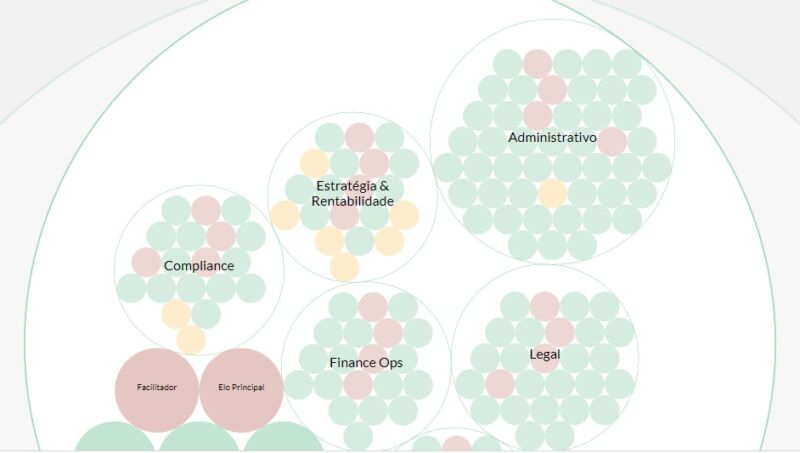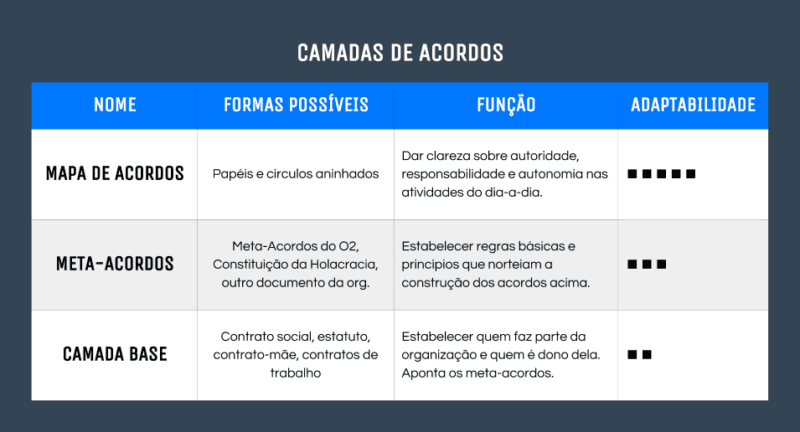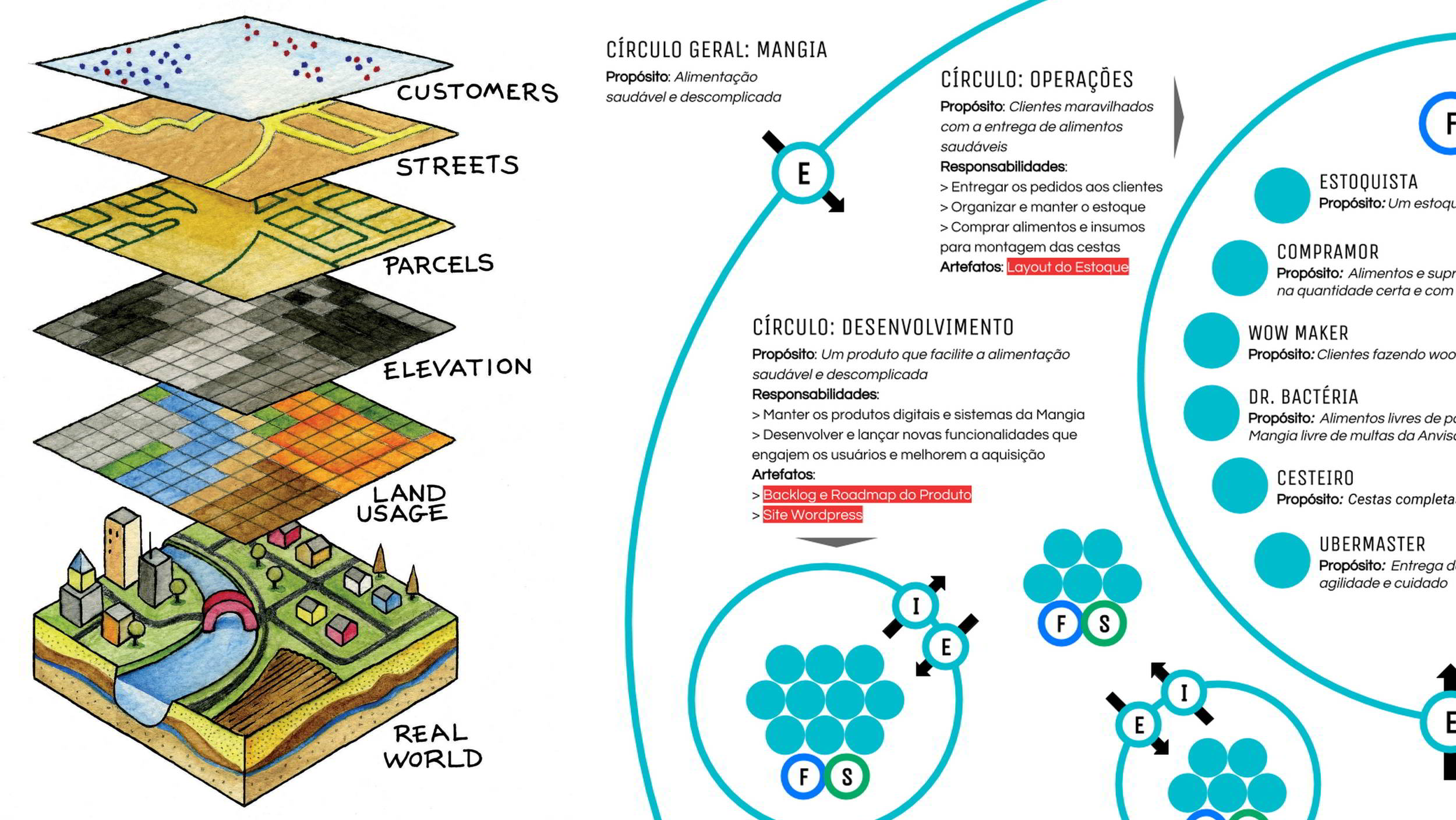When explaining my work as an organizational designer at Target Teal, I referred to the use of the organizational structure as an important tool. And this was often seen by the interlocutor with strangeness or even aversion.
The reason is that people associate the organizational structure with something imposed (top-down) and rigid. Something that does not reflect the countless and rich interactions necessary for the flourishing of a collaborative environment.
I started naming things in a different way and realized that the reception was different. In fact, my head started making connections that I hadn’t made before. What we usually call (here at TT) organizational structure is actually a map of agreements.
Yes, I stopped using the term organizational structure of nested circles (wow, what ugly jargon). Now I only talk about a map of agreements. And with that I began to understand that our work could be defined as the exercise and sharing of the art of making agreements.
Let’s go to the map first.
Map of agreements
If we really want to have a work environment reigned by peer-to-peer relationships and without the annoying (not to say nefarious) presence of the boss-subordinate relationship, we need to learn how to build agreements.
Agreements that help us clarify and remember in what way responsibility, authority and autonomy are at this moment divided among people who are part of an organization. We define authority as the formal authorization given by a group for someone to make a decision that may impact the group. You can better understand our definition of responsibility here and autonomy here.
However, we have two problems that cannot be ignored. First, as the number of people grows in an organization, the number of possible interactions (relationships) grows following a geometric progression. Number of relationships = n(n-1)/2, or analogous to this animated gif:
Another problem is that we cannot believe in the idea that once the agreements that define responsibility, authority and autonomy are made, we will not need to review and adapt them.
The volume of agreements and the need for constant adaptation by a large number of people impose challenges that we are not used to. That is why common strategies for making agreements between two people, such as a couple where household chores are divided, tend not to work in the organizational environment. We need to make much more things explicit (written down) and adjust these agreements much more quickly.
We also cannot use only legal mechanisms (formal contracts) for these agreements, as they would not have the necessary adaptability.
So far I have not found a better way than a map of agreements constituted by roles and circles. Once you learn how they work and the organization appropriates decision-making processes like those described in the social technology O2, these agreements come to life and become a beautiful expression of collaborative work. Wow, and how they help make the environment lighter and more focused.

Map of agreements, drawn within the Holaspirit app. Another example here.
There is only one problem: this map of agreements has its own logic and adaptation mechanisms that also need to be the object of an agreement between the people in the organization. They are not born from a free conversation or debate. Here we enter the concept of meta-agreements.
Meta-Agreements
We need something that allows the creation of this map of agreements described above. Something that establishes the bases and principles. In O2, we call this meta-agreements. Agreements on how to make agreements. Before we called it the O2 rule book and in the same way as the term organizational structure, it had a not very good effect the first time someone heard it.
You can read these meta-agreements of O2 in its version 2.2 here on Github. Holacracy also has its meta-agreements, there called constitution. Sociocracy 3.0 asks that you build your set of meta-agreements from the beginning and gradually grow it.
In O2 you can also change and adapt these meta-agreements, but there is already a coherent and safe enough starting point. In addition to having been created for organizations that want to make the transition to this new way of organizing work, which facilitates a lot.
If you want to learn about how these meta-agreements work, the intensive O2 workshop is perfect for that.
The deepest layer
Perhaps you are wondering, okay, but who decides that the organization should follow these meta-agreements? So, that would be a prerogative of the deepest layer of agreements. The agreements that constitute the organization and define who is associated with it.
I am talking about the social contract of a company, the statute of an association or the joint-venture style contract like the Target Teal mother-contract.
Other agreements exist in parallel in this layer. The employment contracts for example. Or those that define conflict resolution mechanisms between partners through smart contracts on the blockchain.
Thus, we have agreements in three layers:

The future
It is very difficult to make a prediction of how this art of making agreements will develop in the coming decades. I am only sure that it will be an incredible journey.
More and more organizations that depend on coercion to organize work will have difficulty finding willing people. In addition, those that are unable to adapt to the VUCA world, due to heavy and rigid processes, will also suffer.
The future belongs to organizations proficient in the art of making agreements.
If you want to chat about how to create agreements in your organization, just schedule a coffee.






Oi, Rodrigo, parabéns pelo ótimo texto e pela organização dos conceitos.
Estamos discutindo estes temas na empresa que trabalho e eu gostaria muito de compartilhar o seu texto com o time. Você teria uma versão completa em inglês deste artigo, com imagens traduzidas?